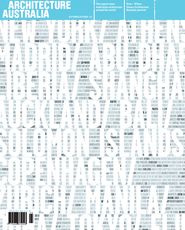
Video still of Umbra: Penumbra: Antumbra by Brodie Ellis. Photograph: Brodie Ellis, Ocea Sellar.
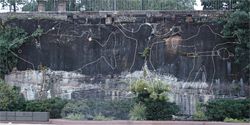
Djon Mundine’s concept image for The Song of Bennelong and Pemulwuy, 2010, project for Tarpeian Way, Bennelong Point, Sydney. Produced by Campbelltown Arts Centre in association with the Biennale of Sydney.
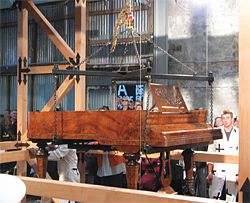
The Fatal Score or The Spectacle of the Scaffold (The Way Up and the Way Down are One and the Same) by Slave Pianos. Photograph by Robert Pavlacic.
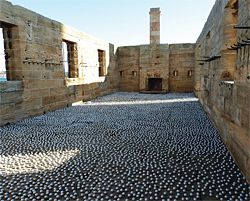
Molecular (SYDNEY) by Serge Spitzer. Photograph by sergespitzerstudio.
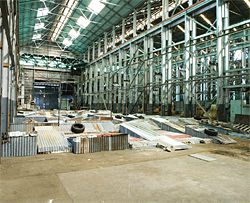
Kasbah by Kader Attia. Photograph by Ben Symons.
Art, architecture and the (pre) occupation of space – Tom Rivard considers the Sydney Biennale.
The detective story has always been about the city. Or rather, about trying to understand the city. Plot just doesn’t matter; the private eye simply attempts to intuit a personal order from universal chaos. Architecture has always had an uneasy relationship with art, not unlike that of the shabby detective and the classy, mysterious dame who wafts into his office, flummoxing him into doing, well, whatever she damn well pleases.
The seventeenth Sydney Biennale promised, as these things must, boundless innovation and an immersive experience that took as one of its starting points “the city” (and Sydney’s voluptuous topography), along with the “state of contemporary art and the world around it”. What better place to locate such an agenda than the city, forever an instrument for both siting and accommodating difference? As such, the enterprise proposes that works of art, skilfully deployed, tell us as much about the measure of our world as about the art itself.
This is necessary: after Nietzsche did away with God, the next big sacred sacrificial cow looming its lowing head over the horizon was art. Damien Hirst hammered the final nails just recently, though with a century-long assist from Duchamp.¹ If “art” has any power left to engage us (in a real way, as opposed to activating our ready cynicism and self-awareness in the circus tent that is capitalist consumer culture), it is outside the frame of the institution, beyond the sanction of the “museum”.
Wandering through the city, we are as likely to encounter an invisible sense of the indigeneity of place – the deeply local – as we are to read an equally legible but placeless exhortation; trees and ads line our streets in equal densities.² We construct our city by association of such phenomena, and even a gratuitous choice creates a context, a personal semblance of order. A bastard offspring of the “Art” family that might propagate such relevance is installation work, encountered, necessarily, beyond the confines of the gallery. Such works do not inevitably demand complexity of form, only complexity of content, part of which is provided by the locations themselves, part by the participants. However, as an urban presence the biennale is relatively nonexistent, bunkered in its sandstone temples, only two lonely works making up the Botanic Gardens’ “art walk”.
Strangely, it may be that the most significant work in the Biennale is one that is not there: Djon Mundine’s yet-to-be-realized work The Song of Bennelong and Pemulwuy, due to be carved into the rock face of the Tarpeian Way opposite the Opera House. Astonishingly, it will be, if realized, Sydney’s first permanent Aboriginal memorial, referring to freedom fighter Pemulwuy and cultural ambassador Bennelong. Given the Indigenous practice of making art as ritual exchange, the eventual carving into the rock is only one episode in the life of the work, and not simply the work itself. One might suggest that it’s a 200-year-old work, somewhere in its middle stages of realization. This is what we can expect when art is not placed, but planted – like a tree, or like a land mine.
And so to Cockatoo Island, major venue for the biennale, and perhaps the premier example in a series of locations around Sydney that alter our perceptions of what public space is and what it can be. Despite well-meant attempts to sanitize the island, it defiantly retains both its tectonic grandeur and the scars of its barbaric history, a perfect location, one would think, for the insinuation of art that is not Art. The current discourse about these emergent spaces ought not to be with the architecture (existing or new) or the spaces themselves; beyond allowing a pastoral appreciation of Sydney’s natural wonders, the problem remains that it is unclear exactly what should take place in these spaces. Sites like this, though, can engender a more productive approach to making art that is both resistant and relevant, focused on the work’s relationship to environment (natural, human-made, social, virtual), a rejection of a second nature that exists only in the work. As the particulars of culture are elided by globalization, strategies for re-engagement of the local become more valuable as the field of art is subsumed by both commerce and critique. Reconsidered relationships between art and the public realm have the potential to provoke, to illuminate these new possibilities.
Cockatoo’s character, though, is the curator’s curse; its visceral reality easily overawes any work of questionable reality – and questioning reality is a leitmotif of contemporary art. Video art, in particular, suffers from incorporeality and placelessness all at once; most of it is hardly there at all.
The same might be said of much displayed on the island, disembodied Art longing for a proper home where it could be, if not appreciated, at least consumed.³
There are notable exceptions. Penalogical Pianology – an installation by Slave Pianos in a dirt-floored interstitial space, in which a condemned piano is “hung by the neck until dead” – resonates within the site, while presenting its own evilly witty industrial machinery of movement and death.
Brodie Ellis presents Umbra:Penumbra:Antumbra in one of the nondescript brick buildings in the dock precinct. While projection is central to this work, totemic steel constructs arrayed in the dark space create a shadow operation of menace and dislocation, some arcane mechanical processing.
In the roofless guard barracks atop the hill (where guards could barricade themselves during a convict uprising and mow down the marauding hordes) is Serge Spitzer’s Molecular, a sea of lead balls strewn across the floor, remnant of and silent witness to some atrocity, survivors unknown.
And finally there is one work that manages to have it all, plus some, and at our expense, thankfully. Kader Attia’s Kasbah, located in one of the grand machine halls in the industrial precinct, is a trafficable collage of actual shantytown roofs, a topography of tin and old tyres sprouting brand new TV aerials and satellite dishes. Encouraged to tread on this Third World roofscape, everyone does, in enthusiastic stomps, revelling in the experiential delight of actually being able to engage with a work physically, marvelling at the cacophonous fit between the assembled junk and the battleship architecture around it, while at the same time proudly discovering the wit (ours, of course) inherent in the contrast between the DIY roofs and the electronic totems crowning them.
However, it’s not until you depart from the space (fittingly, through faux brick walls left over from the filming of Wolverine) that you witness the final (and breathtakingly brilliant) layer of this artwork: a tableau of enlightened art consumers (and their keen kiddies) clomping and whooping literally over the heads of the developing world, and priding themselves on their appreciation of the experience.
Art is hardly ever this powerful and personally engaging:
we have the last laugh on ourselves, shot right through the middle of our consciousness, and when we least expected it.
We can only walk away, arm in arm with Jack Nicholson, back to our reality, reduced, but that tiny bit wiser.
It’s Chinatown, Jake.
Tom Rivard is the director of Lean Productions.
Endnotes
1. Art is dead, but we haven’t yet found the body. More than likely, it’s been sold for parts to oligarchs and the members of the extended Gecko Clan.
2. Thankfully, no clever young thing has yet thought to conflate them – stay tuned.
3. Overheard: “I wouldn’t mind hanging those in my bedroom.” This was not, sadly, said of Cai Guo-Qiang’s much hyped flipflopping cars in the Turbine Hall. With their careful choreography and Vegas lighting, they seemed like so much extravagant party decoration; in fact, at the opening night that’s exactly what they were.

